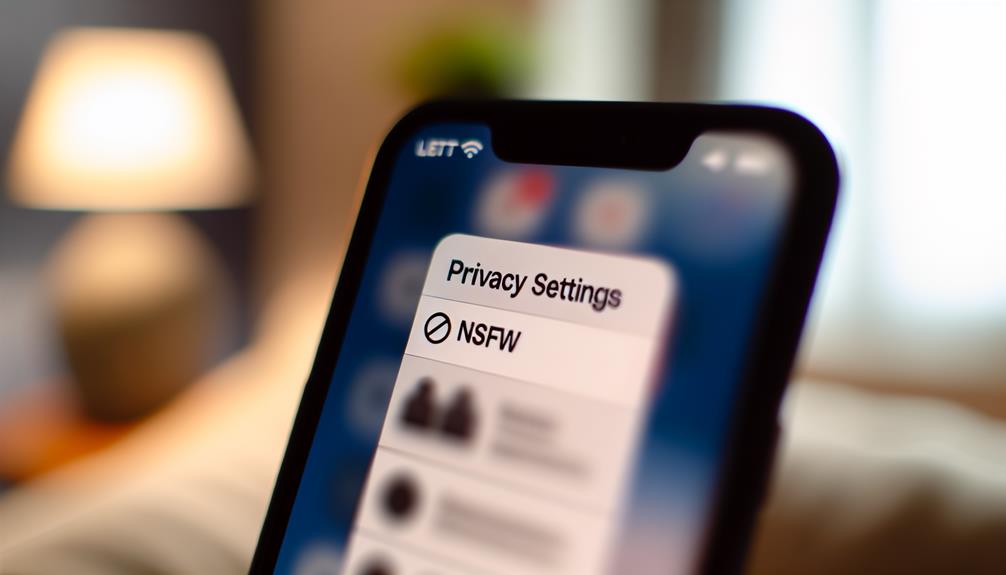Managing NSFW content settings on Twitter involves several steps to enhance user experience and safety. Users should navigate to the settings menu via the profile icon, where privacy and security options can be adjusted. Key features include enabling content filters, hiding sensitive media, and blocking users who share unwanted content. Additionally, actively reporting inappropriate material contributes to community standards. Regularly reviewing these settings allows for ongoing customization based on personal preferences. Ultimately, understanding and adjusting these parameters creates a more controlled and enjoyable online environment, leading to further exploration of effective management strategies.
Key Takeaways
- Access the settings menu via your profile icon to adjust privacy and safety options for managing NSFW content.
- Enable content filters to automatically hide sensitive or inappropriate tweets based on your preferences.
- Utilize the option to hide sensitive tweets and control who can interact with your account for a safer experience.
- Regularly monitor and update your settings to ensure they align with your changing preferences regarding NSFW content.
- Report any inappropriate content by selecting "Report" and providing clear descriptions to help maintain community standards.
Understanding NSFW Content on Twitter

Maneuvering the complexities of NSFW (Not Safe for Work) content on Twitter requires a clear understanding of its definition and implications. NSFW definitions typically encompass content that may be deemed inappropriate for professional settings, often including explicit language, sexual imagery, or graphic themes. It's important to recognize that terms like "FR" and "FRFR" can also emerge in discussions about such content, reflecting various levels of agreement or emphasis among users an expression of agreement. Audience perceptions of such content vary considerably, influenced by individual values, cultural norms, and personal experiences. This divergence plays a vital role in shaping user interactions and engagement on the platform. Recognizing these distinctions is essential for both content creators and consumers, as it informs expectations and guides behavior within this digital landscape. Therefore, a nuanced comprehension of NSFW content not only enhances user experience but also fosters a sense of community among diverse audiences maneuvering these intricate dynamics.
Accessing Your Twitter Settings
Accessing your Twitter settings is a critical step in managing your experience on the platform, especially regarding NSFW content. Understanding the implications of your settings can greatly enhance your online interactions, just as evaluating the pros and cons of a career path can inform your decisions in life is a Remote Customer Service Career Right for You. To begin, navigate to your profile icon, which will direct you to the settings menu. Here, you will find various options pertaining to account security and user preferences. Ensuring that your account is secure is paramount; consider enabling two-factor authentication to protect your information. Within the settings, you can tailor your user preferences to align with your comfort level regarding NSFW content. This includes options to limit visibility and manage what content appears on your timeline. By taking these proactive steps, you enhance not only your personal experience but also contribute to a more respectful community on Twitter.
Adjusting Privacy and Safety Options

To effectively manage NSFW content on Twitter, it is essential to adjust your privacy and safety options. These settings play a significant role in shaping your user interactions and enhancing content awareness. Moreover, just as streamlining your messages can improve organization and security, customizing your Twitter experience can help filter out unwanted content. By steering through the privacy and safety section, users can customize their experience to filter out undesirable content while promoting a secure environment for engagement. Options such as hiding sensitive tweets and controlling who can interact with your posts allow for a tailored experience that aligns with personal comfort levels. In addition, monitoring and adjusting these settings periodically guarantees that users remain aware of their content exposure, fostering a sense of belonging within the Twitter community. Ultimately, thoughtful adjustments contribute to a more positive and controlled online experience.
Filtering Sensitive Media
While traversing the complexities of Twitter, effectively filtering sensitive media is essential for maintaining a safe and comfortable user experience. Users can navigate content visibility options to adhere to sensitive media guidelines, ensuring their feeds reflect their preferences. For instance, utilizing educational platforms can enhance one's ability to discern appropriate content, which parallels how Study Island evaluates learning tools for effectiveness. Key strategies include:
- Adjusting privacy settings to limit exposure to sensitive content.
- Utilizing the "Show media that may contain sensitive content" option for a curated experience.
- Engaging with accounts that align with personal comfort levels.
- Regularly reviewing and updating preferences based on changing needs.
- Reporting any content that appears to violate these guidelines.
Reporting Inappropriate Content

Effective management of NSFW content on Twitter also involves the proactive reporting of inappropriate material. Users play a significant role in content moderation by adhering to established reporting guidelines, which facilitate the identification of harmful content. The reporting process empowers users to contribute to a safer online environment.
| Action | Description |
|---|---|
| Identify Inappropriate Content | Recognize content that violates guidelines. |
| Use Reporting Tools | Access the report option under the tweet. |
| Select Reason | Choose from predefined categories for clarity. |
| Submit Report | Send the report for review by Twitter. |
| Monitor Feedback | Keep an eye on updates regarding your report. |
Tips for a Safer Experience
To enhance user safety on Twitter, it is essential to implement specific strategies. Adjusting privacy settings, utilizing content filters, and actively reporting inappropriate content can greatly reduce exposure to NSFW material. Additionally, engaging with content creation tools can provide a more enjoyable experience, such as learning how to create crossword puzzles for interactive fun. These measures empower users to tailor their experience and maintain a more secure environment on the platform.
Adjust Privacy Settings
Adjusting privacy settings on Twitter is essential for users seeking a safer online environment, particularly in relation to NSFW content. By fine-tuning these settings, users can cultivate a more tailored experience that aligns with their comfort and safety levels. Consider the following strategies:
- Block users who share unwanted NSFW content
- Customize notifications to minimize disturbances from inappropriate posts
- Set your account to private to control who can see your tweets
- Filter who can send you direct messages
- Regularly review your followers and remove any that make you uncomfortable
These adjustments not only enhance personal security but also foster a sense of community by allowing users to engage more freely without the anxiety of encountering unwanted content.
Use Content Filters
Exploring Twitter's vast landscape can be intimidating, especially when it comes to encountering NSFW content. To enhance your experience, utilizing content filters is crucial. These filters allow users to customize their content visibility according to individual preferences, minimizing exposure to unwanted material. By accessing the privacy and safety settings, users can enable features that automatically hide sensitive or inappropriate tweets. This personalized approach not only helps maintain a safer environment but also fosters a sense of belonging within the Twitter community. Furthermore, adjusting these filters in accordance with user preferences guarantees that your feed remains engaging and relevant, while reducing the likelihood of encountering distressing content. Overall, content filters serve as an essential tool for managing NSFW interactions effectively.
Report Inappropriate Content
Addressing inappropriate content on Twitter is essential for cultivating a safer online community. Users have a responsibility to report content that violates the platform's reporting guidelines, thereby contributing to a respectful environment. To effectively manage this process, consider the following tips:
- Familiarize yourself with Twitter's reporting guidelines to understand what constitutes inappropriate content.
- Use the reporting feature to flag content that is abusive, harmful, or violates community standards.
- Provide clear and concise information when submitting a report to assist Twitter's review process.
- Monitor the outcomes of your reports to stay informed about community standards.
- Encourage others to report inappropriate content, fostering a collective effort toward a safer platform.
Frequently Asked Questions
What Does NSFW Stand for on Twitter?
NSFW stands for "Not Safe for Work," a designation commonly used online to indicate content that may be inappropriate for professional settings due to its explicit or adult nature. On platforms like Twitter, NSFW definitions play a vital role in user experience and safety. Twitter policies regarding NSFW content aim to maintain a respectful environment while allowing users to engage with diverse material, ultimately fostering a sense of belonging among its community members.
Can I Block Specific NSFW Accounts?
Yes, users have the capability to block specific accounts that post NSFW content, thereby enhancing their content moderation experience. Account blocking is a practical tool that allows individuals to curate their online environment, ensuring they only engage with content that aligns with their preferences. By effectively managing their interactions, users can foster a more comfortable and inclusive atmosphere on the platform, promoting a sense of belonging among like-minded individuals while minimizing exposure to unwanted material.
Does Twitter Notify Users About NSFW Content Settings Changes?
When users modify their NSFW content settings, Twitter does not typically notify them about changes. This approach underscores the platform's commitment to user privacy and content visibility management. By allowing individuals to adjust these settings without alerts, Twitter fosters an environment where users can curate their experience with minimal intrusion. However, it remains vital for users to regularly review their settings to guarantee their content visibility preferences align with their privacy expectations.
How Often Should I Review My NSFW Settings?
Regularly reviewing your NSFW settings is essential to guarantee they align with your current preferences and comfort levels. A frequency review every few months is advisable, as changes in content policies or personal circumstances may influence your desired settings impact. This proactive approach allows users to maintain a safe and enjoyable online experience, fostering a sense of belonging within communities that reflect their values and preferences. Adaptability is key in today's dynamic digital landscape.
Are There Age Restrictions for Viewing NSFW Content on Twitter?
Age restrictions for viewing NSFW content are essential for protecting younger audiences. Platforms typically implement age verification measures to guarantee compliance with legal standards and community guidelines. Content warnings serve as an additional safeguard, informing users about explicit material before they engage. By maintaining these practices, platforms can foster a safer online environment, allowing users to make informed decisions about their viewing experiences while promoting responsible content consumption.


